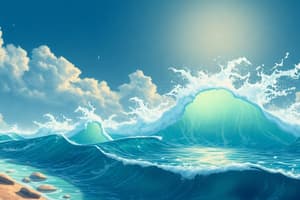Podcast
Questions and Answers
What do diatoms and dinoflagellates function as in the ecosystem?
What do diatoms and dinoflagellates function as in the ecosystem?
- Decomposers
- Scavengers
- Primary producers (correct)
- Top predators
What is the relationship between biomass and trophic level?
What is the relationship between biomass and trophic level?
- Biomass remains constant across trophic levels
- There is a decrease in biomass as trophic level increases (correct)
- There is an increase in biomass as trophic level increases
- Biomass fluctuates unpredictably across trophic levels
What does the biomass pyramid reveal about the mass of primary producers compared to the top predator?
What does the biomass pyramid reveal about the mass of primary producers compared to the top predator?
- Primary producers have a much larger mass (correct)
- Both have similar mass
- The mass is not related to trophic level
- Top predators have a much larger mass
What is the main difference between a food chain and a food web?
What is the main difference between a food chain and a food web?
What are copepods eaten by?
What are copepods eaten by?
What is the primary cause of the Gulf of Mexico dead zone?
What is the primary cause of the Gulf of Mexico dead zone?
What is the main factor contributing to the occurrence of red tides?
What is the main factor contributing to the occurrence of red tides?
What is the impact of eutrophication on water bodies?
What is the impact of eutrophication on water bodies?
What is the consequence of consuming seafood affected by Harmful Algal Blooms (HABs)?
What is the consequence of consuming seafood affected by Harmful Algal Blooms (HABs)?
What activity exacerbates harmful algal blooms (HABs) according to the lecture?
What activity exacerbates harmful algal blooms (HABs) according to the lecture?
What prevents nutrient resupply to the surface in some open ocean regions?
What prevents nutrient resupply to the surface in some open ocean regions?
Which factor contributes to high productivity in polar oceans in summer?
Which factor contributes to high productivity in polar oceans in summer?
What type of open ocean region generally experiences low productivity?
What type of open ocean region generally experiences low productivity?
What happens to polar ocean productivity in winter?
What happens to polar ocean productivity in winter?
What helps move material from the photic zone to the seafloor in the open ocean?
What helps move material from the photic zone to the seafloor in the open ocean?
What limits productivity in tropical oceans?
What limits productivity in tropical oceans?
What leads to low productivity in temperate oceans during summertime?
What leads to low productivity in temperate oceans during summertime?
What marks the beginning of a huge bloom in temperate oceans?
What marks the beginning of a huge bloom in temperate oceans?
What depicts the seasonal changes in sunlight and nutrients in marine ecosystems?
What depicts the seasonal changes in sunlight and nutrients in marine ecosystems?
What are examples of primary producers in marine ecosystems?
What are examples of primary producers in marine ecosystems?
What is the process in which marine organisms take in seawater and filter out usable organic matter?
What is the process in which marine organisms take in seawater and filter out usable organic matter?
What do decomposers do in marine ecosystems?
What do decomposers do in marine ecosystems?
Which organism skips trophic levels and goes directly to zooplankton as a food source?
Which organism skips trophic levels and goes directly to zooplankton as a food source?
What represents different feeding stages in marine ecosystems?
What represents different feeding stages in marine ecosystems?
What makes up the majority of biomass in marine ecosystems?
What makes up the majority of biomass in marine ecosystems?
Flashcards are hidden until you start studying
Study Notes
Ocean Energy Transfer and Feeding Relationships
- In the upper layers of the ocean, energy enters the system and is transferred through chemical energy to consumers, with much of it expended as moving or mechanical energy and heat loss.
- Decomposers recycle nutrients by breaking down dead organisms and waste products, which serves as nutrients for other organisms in the biogeochemical cycle.
- Nutrient flow in marine ecosystems is cyclical, with algae and plants producing their own food and oxygen and bacteria decomposing the detritus, returning nutrients into the water.
- Marine organisms have developed various feeding strategies including suspension feeding, filter feeding, and deposit feeding.
- Suspension feeding involves taking in seawater and filtering out usable organic matter, as seen in barnacles and clams.
- Deposit feeding involves extracting usable organic matter from sediment, as exemplified by lugworms and mole crabs.
- Carnivorous feeding occurs when an animal captures and eats other animals, such as the sand star preying on clams.
- Trophic levels represent different feeding stages, with energy transferred from producers to consumers, and only about 10% of energy being transferred to the next trophic level.
- The exception is the blue whale, which skips trophic levels and goes directly to zooplankton, feeding on krill.
- In terms of biomass, producers make up the majority, followed by herbivores, and then carnivores, with only about 10% of energy transferred between each feeding stage.
- Flow efficiency shows that only a small percentage of radiant energy is converted to primary producers, and as energy is transferred through trophic levels, biomass and energy efficiency decrease.
- Direct feeding relationships among different organisms form the food chains in marine ecosystems, with 10% efficiency of energy transfer, resulting in smaller populations at the top of the food chain.
Studying That Suits You
Use AI to generate personalized quizzes and flashcards to suit your learning preferences.





